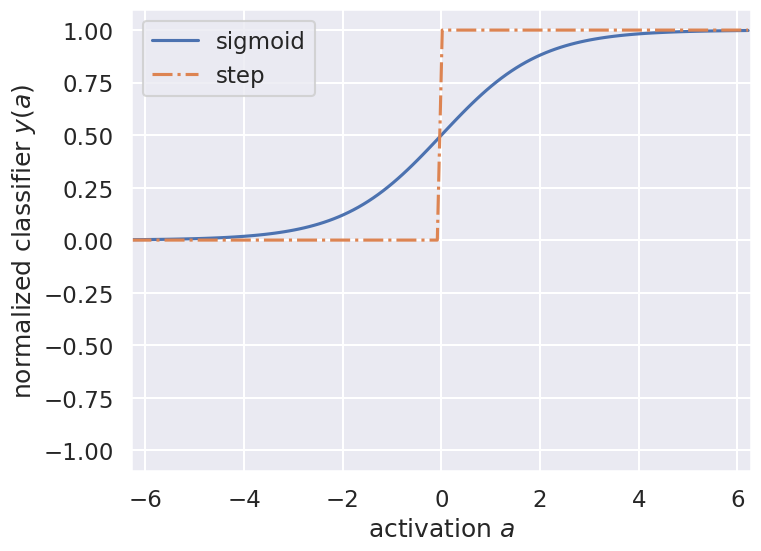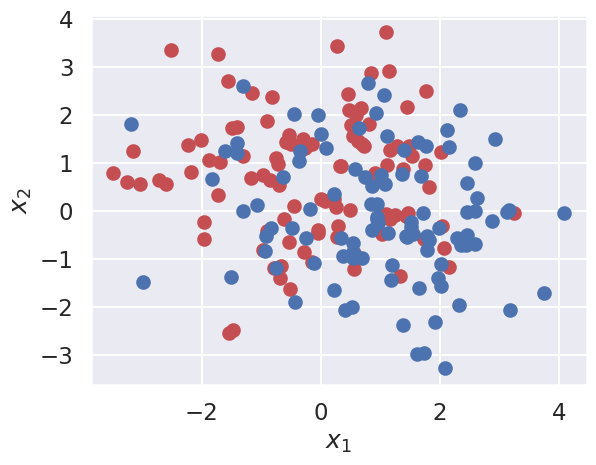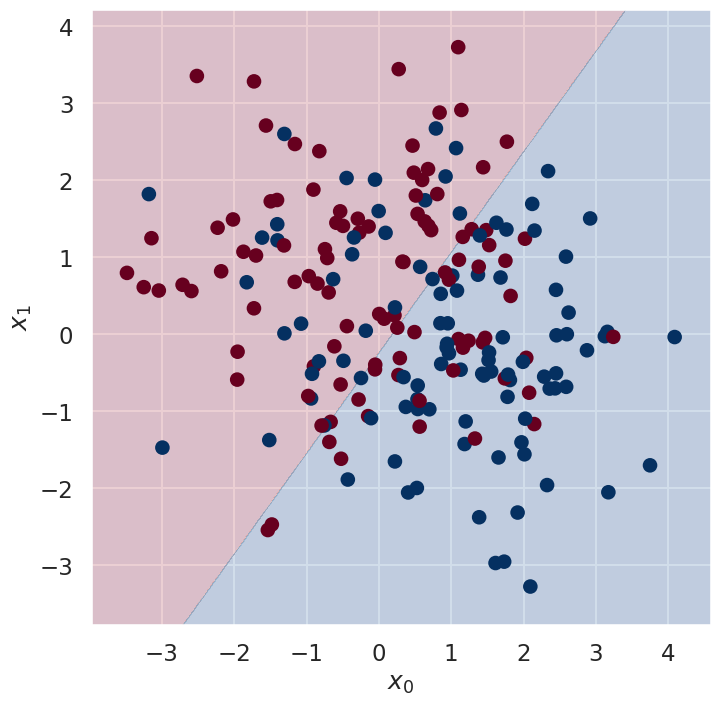23.6. Exercise: Logistic Regression and neural networks#
%matplotlib inline
import numpy as np
import matplotlib.pyplot as plt
import seaborn as sns
sns.set()
sns.set_context("talk")
Examples of classifier functions used in logistic regression and neural networks#
The following code plots the sigmoid and the step function, two common classifier functions used in neural networks (and logistic regression).
a = np.arange(-2*np.pi, 2*np.pi, .1)
sigma_fn = np.vectorize(lambda a: 1/(1+np.exp(-a)))
sigma = sigma_fn(a)
fig = plt.figure(figsize=(8,6))
ax = fig.add_subplot(111)
ax.plot(a, sigma, label='sigmoid')
# Step Function
step_fn = np.vectorize(lambda a: 1.0 if a >= 0.0 else 0.0)
step = step_fn(a)
ax.plot(a, step, '-.', label='step')
ax.set_ylim([-1.1, 1.1])
ax.set_xlim([-2*np.pi,2*np.pi])
ax.set_ylabel('normalized classifier $y(a)$')
ax.set_xlabel(r'activation $a$')
ax.legend(loc='best');

Exercise#
Add the tanh function.
Add the ReLU, leaky ReLU, and ELU activation functions (find the functional forms online)
A simple classification problem#
scikit-learn includes various random sample generators that can be used to build artificial datasets of controlled size and complexity.
For example, make_moons generates two overlapping half cricles with optional Gaussian noise.
from sklearn import datasets, linear_model
Logistic regression using scikit-learn#
np.random.seed(0)
X, y = datasets.make_moons(200, noise=1.20)
X.shape
(200, 2)
y.shape
(200,)
fig,ax=plt.subplots(1,1)
ax.scatter(X[y==0,0],X[y==0,1],c='r')
ax.scatter(X[y==1,0],X[y==1,1],c='b')
ax.set_xlabel(r'$x_1$')
ax.set_ylabel(r'$x_2$');

clf = linear_model.LogisticRegressionCV(cv=5,penalty='l2')
clf.fit(X, y)
LogisticRegressionCV(cv=5)In a Jupyter environment, please rerun this cell to show the HTML representation or trust the notebook.
On GitHub, the HTML representation is unable to render, please try loading this page with nbviewer.org.
Parameters
| Cs | 10 | |
| fit_intercept | True | |
| cv | 5 | |
| dual | False | |
| penalty | 'l2' | |
| scoring | None | |
| solver | 'lbfgs' | |
| tol | 0.0001 | |
| max_iter | 100 | |
| class_weight | None | |
| n_jobs | None | |
| verbose | 0 | |
| refit | True | |
| intercept_scaling | 1.0 | |
| multi_class | 'deprecated' | |
| random_state | None | |
| l1_ratios | None |
clf.coef_
array([[ 0.1850492 , -0.14189485]])
clf.intercept_
array([-0.0343265])
# Helper functions to visualize the data and the decision boundary
#
def visualize(X, y, clf,ax=[]):
plot_decision_boundary(lambda x: clf.predict(x), X, y, ax=ax)
def plot_decision_boundary(pred_func, X, y,ax=[]):
# Set min and max values and give it some padding
x0_min, x0_max = X[:, 0].min() - .5, X[:, 0].max() + .5
x1_min, x1_max = X[:, 1].min() - .5, X[:, 1].max() + .5
h = 0.01
# Generate a grid of points with distance h between them
xx0, xx1 = np.meshgrid(np.arange(x0_min, x0_max, h), np.arange(x1_min, x1_max, h))
# Predict the function value for the whole gid
Z = pred_func(np.c_[xx0.ravel(), xx1.ravel()])
Z = Z.reshape(xx0.shape)
# Plot the contour and training examples
if ax:
ax.contourf(xx0, xx1, Z, cmap=plt.cm.RdBu, alpha=0.2)
ax.scatter(X[:, 0], X[:, 1], c=y, cmap=plt.cm.RdBu)
else:
plt.contourf(xx0, xx1, Z, cmap=plt.cm.RdBu, alpha=0.2)
plt.scatter(X[:, 0], X[:, 1], c=y, cmap=plt.cm.RdBu)
fig,ax = plt.subplots(figsize=(8,8))
visualize(X, y, clf,ax)
ax.set_xlabel(r'$x_0$')
ax.set_ylabel(r'$x_1$');

Sub-task#
Generate 200 new samples for use as test data.
What is the accuracy of your binary classifier on
The training data
The test data?
Exercise: Develop your own logistic regression binary classifier#
Implement your own logistic regression binary classifier by modifying the function definitions below
Define the sigmoid activation function.
Define the feed-forward function that returns the output of the neuron given some input and weights.
Define the learning algorithm that:
use the cross entropy cost function defined in the lecture. Add an L2 regularizer with
alpha=0.1computes gradients of the cross entropy cost function (i.e. back propagation)
modifies the parameters with a learning rate parameter
eta = 0.01.returns the new weights.
Then:
Train the binary classifier on the data set. Perform rather many iterations.
Plot the decision boundary and compare with the
scikit-learnimplementation above.
def sigmoid(a):
'''
Sigmoid activation function
Args:
a (array[float]): activation signal
Returns:
y (float): the output of the neuron
'''
# Add code here (remove the dummy lines)
y = None
return y
def single_neuron(x, w):
"""
Single neuron prediction.
Args:
x (array[float]): input to the neuron
w (array[float]):
Returns:
y (float): the output of the neuron
"""
if len(np.array([x1[0],x2[1]]).shape)==1:
x = np.append(1, x)
else:
m = len(x)
x = np.c_[np.ones((m, 1)), x]
assert(len(w)==x.shape[-1])
a = np.dot(x,w)
return sigmoid(a)
def single_neuron_binary_classifier(x, t, iters=10000, alpha=0.1, eta0=0.01):
"""
Makes predictions for a single neuron binary classifier
Args:
x (array[float]): an array of input data
t (float): target output for each data points
iters (int): number of iterations to apply gradient descent
alpha (float): a rescaling parameter for the weights
eta (float): learning rate
Return
w (array[float]): the trained weights of the classifier
"""
# Insert code here (remove the dummy lines)
w = None
return w
Sub-tasks and follow-up questions#
Plot the decision boundary \(p(t=1|x_1,x_2,w_0^*, w_1^*) = 0.5\), where \(w^*\) are the optimized weights.
Why does it correspond to a straight line?
What is the accuracy for the training set?
Create a test set. What is the accuracy on that?
What would be needed to construct a better classifier that could handle the complicated class boundary?
Exercise: Create a neural net binary classifier#
Import and use tensorflow to create a (non-linear) binary classifier
Build a keras sequential model as in the
demo-NeuralNet.ipynbexample. A single hidden layer is sufficient.Print a summary of your model. How many parameters does it have?
Train the binary classifier on the training data set. Try with different activation functions and different number of epochs of training.
Plot the decision boundary and compare with the Logistic Regression implementations above.
What is the accuracy on the test set?
# Install TensorFlow by updating the conda environment
# Download the latest version of the environment.yml file
# (with tensorflow on the last line)
# Then run:
# conda env update -f /path/to/environment.yml
import tensorflow as tf
---------------------------------------------------------------------------
ModuleNotFoundError Traceback (most recent call last)
Cell In[14], line 7
1 # Install TensorFlow by updating the conda environment
2 # Download the latest version of the environment.yml file
3 # (with tensorflow on the last line)
4 # Then run:
5 # conda env update -f /path/to/environment.yml
----> 7 import tensorflow as tf
ModuleNotFoundError: No module named 'tensorflow'

